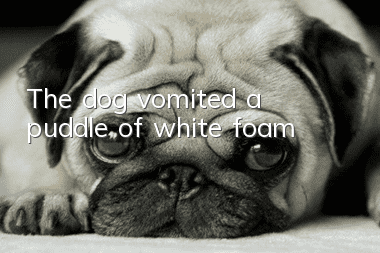What to do if a spaniel is in shock. Treatment and rescue methods for a spaniel in shock.

What to do if a Spanish beagle is in shock? Accidental shock in dogs is a clinical syndrome in which dogs are attacked by strong pathogenic factors, leading to a sharp reduction in effective circulation and microcirculatory blood flow obstruction.
Canine shock is divided into: hypovolemic shock, septic shock, cardiogenic shock, anaphylactic shock and neurogenic shock.
The characteristics of canine shock are: rapid mental sluggishness or irritability, physical weakness, cold limbs, moist and pale skin, thin and rapid pulse, and drop in blood pressure. If not rescued in time, it can often be life-threatening.
1. Causes of shock in dogs
1. Hypovolemic shock. Often due to large amounts of bleeding or loss of large amounts of body fluids. Such as trauma or massive bleeding from internal organs, severe vomiting, diarrhea, etc., which will cause capillaries to extremely contract and expand, or cause ischemia and congestion.
2. Septic shock. Caused by viral and bacterial infections, such as toxic dysentery, sepsis, etc.
3. Cardiogenic shock. Caused by the most dramatic reduction in cardiac blood output, such as acute myocardial infarction, severe arrhythmia, acute heart failure and acute myocarditis.
4. Anaphylactic shock. Caused by the dog's allergy to certain drugs or substances such as penicillin and antivenom, it can cause instant death.
5. Nervous shock. It is caused by severe pain, spinal anesthesia accident, etc.
6. Traumatic shock. Often caused by fractures, severe lacerations, crush injuries, burns, etc.
2. First aid methods for dog shock
1. If the dog's shock is caused by trauma, blood loss and severe pain, the bleeding should be stopped urgently and appropriate pain relief should be provided. If there are any fractures, they should be fixed first to prevent further damage.
2. Let the sick dog lie down in a well-ventilated area, raise its lower limbs, lower its head, and apply a wet towel with cold water to its head to facilitate venous blood return.
3. Make sure to breathe. If breathing is weak, irregular or stops, immediately untie the collar, open the mouth, remove saliva, blood, vomit or any foreign matter in the mouth, and perform artificial respiration.
4. In case of pain, intramuscularly inject 50 mg of analgesic; if it is caused by allergies, the sensitizer should be stopped immediately and intramuscularly inject 1 mg of epinephrine, or 50 mg of promethazine, or 10 mg of dexamethasone. , rescue on the spot; in principle, patients with cardiogenic shock cannot be moved, chest compressions on the heart should be performed, and a doctor should be consulted immediately; patients with septic shock should be sent to the hospital for treatment as soon as possible.
5. Dogs suffering from hypothermia should pay attention to keeping warm. You can raise the room temperature or add a quilt to keep warm, but you cannot use any form of local heating (such as hot water bottles) to avoid dilation of skin blood vessels and reduce blood perfusion of vital organs. flow. People with high fever can apply an ice pack or a towel soaked in cold water to their head to help cool down.
6. If the pulse cannot be measuredThe heartbeat can be detected directly on the left side of the chest near the back of the elbow. If there is no heartbeat, do "heart massage", that is, squeeze the heart hard on the left side of the chest near the back of the elbow, once per second. After the heartbeat recovers, perform artificial respiration.
7. After simple treatment, the sick dog should be sent to the canine hospital for diagnosis and treatment immediately.
- Why do dogs eat their own children?
- What causes vomiting in puppies? Owners cannot take it lightly!
- How to train a dog? How to train dog behavior!
- What’s wrong with dogs’ loose stools?
- Precautions for novices in feeding puppies, a must-read for every dog owner!
- Dangers of shaving dogs When can I shave my dog?
- How sensitive is a dog’s sense of smell? How many times is a dog’s sense of smell that of a human?
- What is the correct way to deworm dogs externally?
- What are the symptoms of a cold in dogs and how should they be treated?
- The appearance characteristics and training methods of Afghan Hound_How much does one cost?



